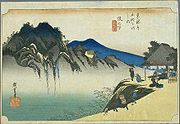
Sakashita-juku
Encyclopedia

53 Stations of the Tokaido
The are the rest areas along the Tōkaidō, which was a coastal route that ran from Nihonbashi in Edo to Sanjō Ōhashi in Kyoto.-Stations of the Tōkaidō:...
of the Tōkaidō
Tokaido (road)
The ' was the most important of the Five Routes of the Edo period, connecting Edo to Kyoto in Japan. Unlike the inland and less heavily travelled Nakasendō, the Tōkaidō travelled along the sea coast of eastern Honshū, hence the route's name....
. It is located in the present-day city of Kameyama
Kameyama, Mie
is a city located in Mie Prefecture, Japan.As of 2006, the city has an estimated population of 48,902 and the density of 256.15 persons per km². The total area is 190.91 km².The city was founded on October 1, 1954....
, in Mie Prefecture
Mie Prefecture
is a prefecture of Japan which is part of the Kansai regions on Honshū island. The capital is the city of Tsu.- History :Until the Meiji Restoration, Mie prefecture was known as Ise Province and Iga Province....
, Japan
Japan
Japan is an island nation in East Asia. Located in the Pacific Ocean, it lies to the east of the Sea of Japan, China, North Korea, South Korea and Russia, stretching from the Sea of Okhotsk in the north to the East China Sea and Taiwan in the south...
.
History
Sakashita flourished as a post townShukuba
were post stations during the Edo period in Japan, generally located on one of the Edo Five Routes or one of its sub-routes. They were also called shukueki . These post stations were places where travelers could rest on their journey around the nation...
during the Edo period
Edo period
The , or , is a division of Japanese history which was ruled by the shoguns of the Tokugawa family, running from 1603 to 1868. The political entity of this period was the Tokugawa shogunate....
because of its location at the entrance to the Suzuka Pass (鈴鹿峠 Suzuka Tōge). However, the Suzuka Pass was also the reason for the post town's decline in the Meiji period
Meiji period
The , also known as the Meiji era, is a Japanese era which extended from September 1868 through July 1912. This period represents the first half of the Empire of Japan.- Meiji Restoration and the emperor :...
; the pass was too steep for rail lines to be laid, so the rail went through Tsuge Station
Tsuge Station
is a train station in Iga, Mie Prefecture, Japan.-Layout:There are a side platform and an island platform with three tracks on the ground level.The Kusatsu line tracks are electrified but the Kansai Line tracks are not.-Stations next to Tsuge:...
(present-day Iga
Iga, Mie
was a town located in Ayama District, Mie Prefecture, Japan.On November 1, 2004 Iga absorbed the old city of Ueno, the towns of Ayama, the villages of Ōyamada and Shimagahara, all from Ayama District, and the town of Aoyama, from Naga District, to become the new city of Iga.-Geography:Located on...
), bypassing the formerly flourishing town.
Today, there are only a few private residences left at the site of the former post station, as well as very little historical architecture. The only thing that marks the former site is a stone marker built by the former town of Seki
Seki, Mie
was a town located in Suzuka District, Mie, Japan.As of 2003, the town had an estimated population of 7,051 and a density of 88.27 persons per km². The total area was 79.88 km².On January 11, 2005 Seki was merged into the city of Kameyama....
.
Neighboring post towns
Tōkaidō- Seki-jukuSeki-juku (Tokaido)was the forty-seventh of the fifty-three stations of the Tōkaidō. It is located in the present-day city of Kameyama, in Mie Prefecture, Japan.-History:...
- Sakashita-juku - Tsuchiyama-jukuTsuchiyama-jukuwas the forty-ninth of the fifty-three stations of the Tōkaidō. It is located in the present-day city of Kōka, in Shiga Prefecture, Japan.-History:...

